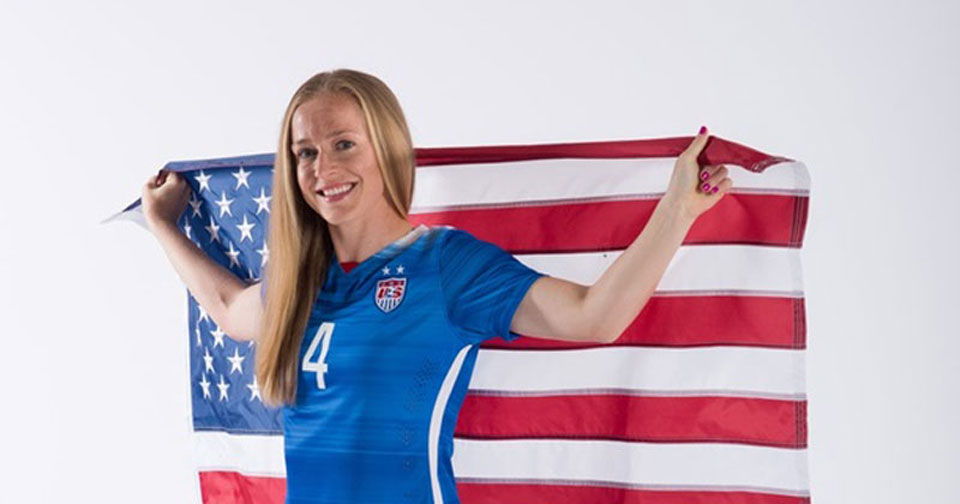
CHICAGO—After years of controversy, one big lawsuit and misogynistic comments by an ousted national soccer federation boss, the talented and medal-winning U.S. National Women’s Soccer team achieved equal pay for equal work with the vastly unsuccessful men’s squad, through simultaneous collective bargaining agreements.
The contracts, signed with the U.S. Soccer Federation on May 18, replace existing pacts and run through 2028. They also negate existing capitalist trends, which consistently favor men.
“The accomplishments in this CBA are a testament to the incredible efforts of Women’s National Team players on and off the field,” said Becky Sauerbrunn, a women’s team member and president of their union, the U.S. Women’s National Team Players Association.
“The gains we have been able to achieve are both because of the strong foundation laid by the generations of WNT players that came before the current team and through our union’s recent collaboration with our counterparts at the USNSTPA”—the men’s team’s union—”and leadership at U.S. Soccer.”
“They said equal pay for men and women was not possible, but that did not stop us and we went ahead and achieved it,” said Walker Zimmerman, a leader of the men’s team’s union.
“We hope this will awaken others to the need for this type of change, and will inspire…others around the world to move in the same direction.”
“We hope this agreement and its historic achievements in not only providing for equal pay but also in improving the training and playing environment for National Team players will similarly serve as the foundation for continued growth of women’s soccer both in the United
States and abroad,” Sauerbrunn added.
The men’s team strongly supported the women’s team’s campaign for equal pay for equal work and equal working conditions, too. Once the bosses–the soccer federation–ousted the misogynistic former president who adamantly refused to even negotiate with the women, it named a new president who did bargain: Former women’s team player Cindy Parlow Cone. She hailed the new pacts, too.
The equal pay will not only cover regular matches in the U.S., match by match, but winnings both teams get for participating in their respective World Cup and Olympic matches—and that’s a big breakthrough for the women.
That’s because FIFA, the international association that rules the sport, distributes huge amounts of prize money, most of it from TV broadcast rights and sponsorships, to men’s teams and relatively little to women’s teams.
Men’s teams in the last World Cup in 2018 got $440 million combined, including $40 million to champion France. Each team, no matter how badly it performed, received millions of dollars. Teams in the 2019 Women’s World Cup got $38 million, combined. The winners—the U.S.—got $3 million. Male-dominated FIFA wants to raise the women’s total for their next World Cup, in 2023, to $60 million, still far from equal.
USSF followed that pattern in paying players, though the women keep winning titles and the men haven’t come close in decades.
Now, the U.S. shares will be combined and the total split evenly among all players. Ditto for “commercial revenue sharing,” the money from corporate sponsors, the two unions said from their Chicago offices.
That’s also important because corporate sponsors have always paid more for televising men’s soccer or plastering their stadiums with signs—though the women have consistently had higher ratings.
Ticket revenue will be equally split, too, with bonuses for sellouts. That, too, benefits the women’s team, as it sells out around the U.S. The men sometimes have sellouts, in cities like Chicago, home to high numbers of migrants from South and Central America.
“Equally as important, the new CBAs improve non-economic terms, including player health and safety, data privacy and the need to balance responsibilities to both club and country,” the two unions said.
Those improvements include equal staffing, equal travel and hotel arrangements and equal-quality fields. Until a federal judge’s decision in the long-running pay discrimination case, the men played on natural grass, which is more forgiving on bodies in the physical sport. The women played on artificial “turf,” equivalent to playing on concrete. And the men flew on chartered planes while the women flew commercial.
The women’s contract has a few extra provisions: Six months paid leave for childbirth and provisions for short-term disability pay. Both contracts include “important protections to prevent harassment,” the unions said. Chauvinists have harassed the women, while male players of color suffered racist taunts.










